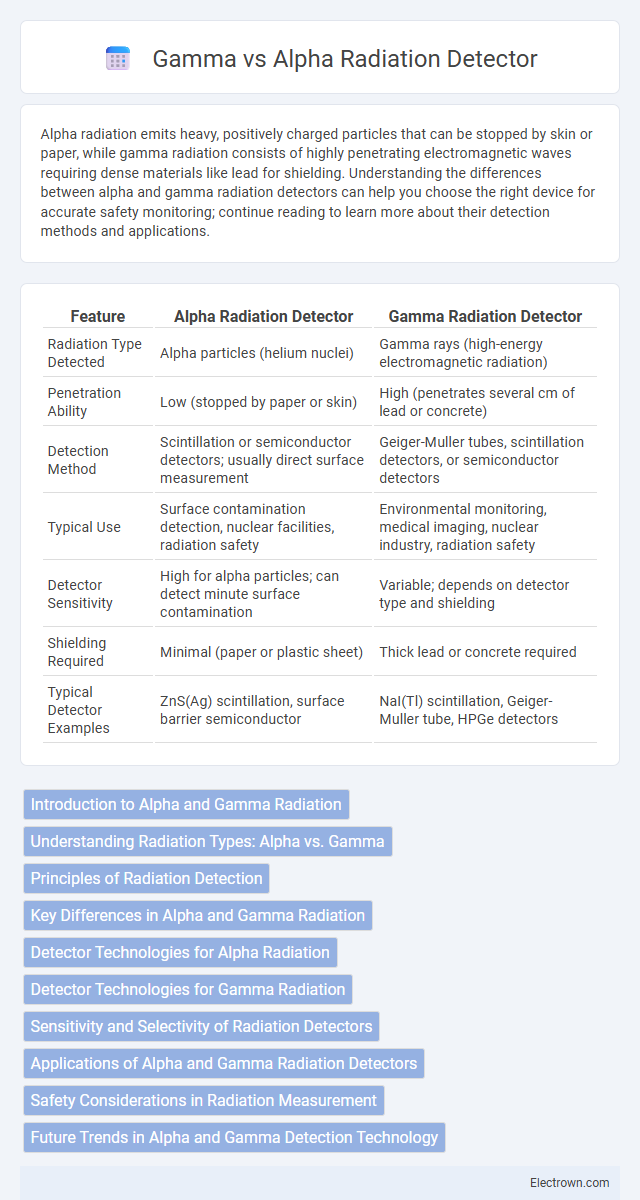Alpha radiation emits heavy, positively charged particles that can be stopped by skin or paper, while gamma radiation consists of highly penetrating electromagnetic waves requiring dense materials like lead for shielding. Understanding the differences between alpha and gamma radiation detectors can help you choose the right device for accurate safety monitoring; continue reading to learn more about their detection methods and applications.
Table of Comparison
| Feature | Alpha Radiation Detector | Gamma Radiation Detector |
|---|---|---|
| Radiation Type Detected | Alpha particles (helium nuclei) | Gamma rays (high-energy electromagnetic radiation) |
| Penetration Ability | Low (stopped by paper or skin) | High (penetrates several cm of lead or concrete) |
| Detection Method | Scintillation or semiconductor detectors; usually direct surface measurement | Geiger-Muller tubes, scintillation detectors, or semiconductor detectors |
| Typical Use | Surface contamination detection, nuclear facilities, radiation safety | Environmental monitoring, medical imaging, nuclear industry, radiation safety |
| Detector Sensitivity | High for alpha particles; can detect minute surface contamination | Variable; depends on detector type and shielding |
| Shielding Required | Minimal (paper or plastic sheet) | Thick lead or concrete required |
| Typical Detector Examples | ZnS(Ag) scintillation, surface barrier semiconductor | NaI(Tl) scintillation, Geiger-Muller tube, HPGe detectors |
Introduction to Alpha and Gamma Radiation
Alpha radiation consists of heavy, positively charged particles emitted from the nuclei of unstable atoms, while gamma radiation is high-energy electromagnetic waves released during radioactive decay. You need specialized radiation detectors, as alpha particles are easily stopped by materials like paper or skin, but gamma rays penetrate deeply and require dense shielding. Understanding the difference in detection methods is crucial for accurate monitoring of radiation in environments with varying radioactive hazards.
Understanding Radiation Types: Alpha vs. Gamma
Alpha radiation consists of heavy, positively charged particles that have low penetration power and can be stopped by a sheet of paper or human skin. Gamma radiation, in contrast, is electromagnetic radiation with high energy and deep penetration ability, requiring dense materials like lead for effective shielding. Understanding these differences helps you choose the appropriate detector type for accurate measurement and safety monitoring.
Principles of Radiation Detection
Alpha and gamma radiation detectors operate on distinct principles tailored to the unique properties of each radiation type. Alpha detectors rely on ionization caused by heavy alpha particles, using materials such as zinc sulfide to detect their limited penetrating power. Gamma detectors utilize scintillation or semiconductor sensors to measure high-energy photons that penetrate deeply, providing accurate detection for gamma radiation in various environments.
Key Differences in Alpha and Gamma Radiation
Alpha radiation consists of heavy, positively charged particles that have low penetration power and can be stopped by a sheet of paper or your skin. Gamma radiation is composed of high-energy electromagnetic waves with deep penetration ability, requiring dense materials like lead or concrete for shielding. Understanding these key differences helps you select the right detector for effective radiation monitoring and safety.
Detector Technologies for Alpha Radiation
Alpha radiation detectors use technologies like scintillation counters, semiconductor detectors, and ionization chambers to accurately measure alpha particles. Scintillation detectors leverage a phosphor material that emits light when struck by alpha particles, while semiconductor detectors utilize silicon or germanium to generate electrical signals upon alpha interaction. Your choice of detector technology depends on factors like sensitivity, energy resolution, and application-specific requirements in radiation monitoring.
Detector Technologies for Gamma Radiation
Scintillation detectors and semiconductor detectors represent key technologies for gamma radiation detection, offering high sensitivity and energy resolution. Sodium iodide (NaI(Tl)) scintillation crystals convert gamma photons into visible light, which photomultiplier tubes then amplify for precise measurement. High-purity germanium (HPGe) detectors utilize semiconductor principles to directly convert gamma rays into electrical signals, enabling detailed spectral analysis crucial for nuclear spectroscopy and radiation safety monitoring.
Sensitivity and Selectivity of Radiation Detectors
Alpha radiation detectors exhibit high sensitivity to alpha particles due to their ability to capture short-range, heavily ionizing radiation, making them ideal for detecting surface contamination. Gamma radiation detectors prioritize selectivity through materials like scintillators or Geiger-Muller tubes optimized to penetrate dense objects and discriminate gamma photons from background noise. Your choice between alpha and gamma radiation detectors should consider the specific sensitivity required for particle type and the selectivity needed to accurately identify radiation sources in diverse environments.
Applications of Alpha and Gamma Radiation Detectors
Alpha radiation detectors are primarily used in nuclear power plants, environmental monitoring, and health physics to detect contamination from alpha-emitting isotopes such as radon or plutonium. Gamma radiation detectors find applications in medical imaging, industrial radiography, and homeland security for identifying radioactive sources and assessing gamma radiation levels. Both detectors play critical roles in radiation safety, ensuring protection from exposure by detecting and measuring specific types of ionizing radiation.
Safety Considerations in Radiation Measurement
Alpha radiation detectors require careful handling since alpha particles cannot penetrate the skin but pose significant internal hazards if inhaled or ingested, making proper protective measures essential. Gamma radiation detectors must be calibrated to accurately measure high-energy photons capable of penetrating most materials, necessitating effective shielding to protect users during measurements. Choosing the right detector ensures your safety by minimizing exposure risks and providing reliable radiation level assessments in diverse environments.
Future Trends in Alpha and Gamma Detection Technology
Advancements in alpha and gamma radiation detectors are increasingly integrating artificial intelligence and machine learning algorithms to enhance detection accuracy and real-time analysis. Portable, low-power devices utilizing novel semiconductor materials and nanotechnology are set to revolutionize field applications by offering heightened sensitivity and faster response times. The growing adoption of wireless sensor networks and IoT connectivity enables comprehensive environmental monitoring and predictive maintenance in nuclear facilities and medical settings.
Alpha vs Gamma Radiation Detector Infographic

 electrown.com
electrown.com